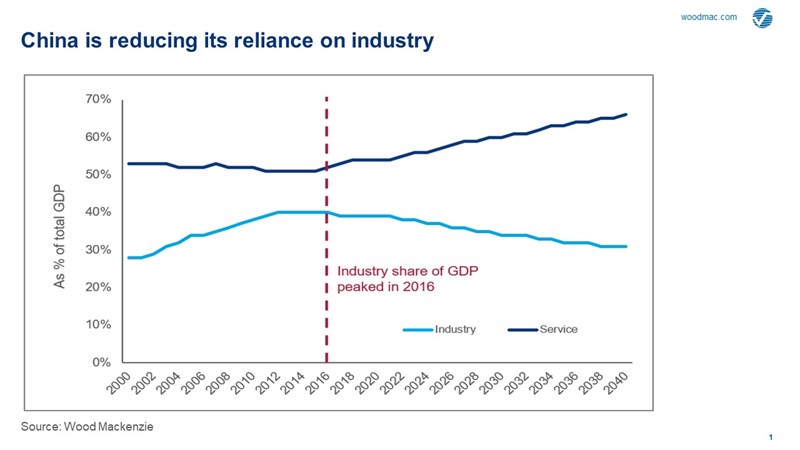China’s war on waste means more than just clean plates
Beijing’s efforts to redefine energy will change the world
1 minute read
Gavin Thompson
Vice Chairman, Energy – Europe, Middle East & Africa

Gavin Thompson
Vice Chairman, Energy – Europe, Middle East & Africa
Gavin oversees our Europe, Middle East and Africa research.
Latest articles by Gavin
-
The Edge
A world first: shipping carbon exports for storage
-
The Edge
WoodMac’s Gas, LNG and the Future of Energy conference: five key themes
-
The Edge
Nigeria’s bold strategy to double oil production
-
The Edge
US tariffs – unpredictability is the strategic planners’ nightmare
-
The Edge
Upside pressure mounts on US gas prices
-
The Edge
The coming geothermal age
In re-launching the ‘Clean Plate’ campaign in August last year, President Xi Jinping urged all of China to “maintain a sense of crisis about food security”. This is of course an important message in and of itself, given the huge amounts of energy, water and land involved in food production in China. But efforts to tackle waste are aimed at more than just food. In China today, excess is out, thriftiness is in.
China’s war on waste is a part of a far broader effort to restructure and repurpose its entire economy, including energy. As China shifted from a labour-intensive to a capital-intensive model, this drove huge levels of investment and a corresponding massive increase in demand for hydrocarbons. As a result, China’s highly energy-intensive economy is not only the world’s largest emitter of carbon and overwhelmingly dependent on others for many of its natural resources, but is also burdened with over-capacity, inefficiency and waste.
China’s leadership is determined to chart an entirely different course. Two recent developments shed light on this. If China’s announcement of a goal of carbon neutrality by 2060 signalled the intent to transform both the economy and how China produces, transports and consumes energy, the recently released 14th five-year plan provided details on how this might be achieved. China is now intent on reducing its reliance on carbon-intensive industries and moving instead towards services, technology and innovation. Underpinning this is a massive shift to cleaner energy. The China of the future intends to be green, efficient and circular.
Efforts towards decarbonisation are well underway. A decade of government and private-sector investment has put China well ahead in virtually all clean energy supply chains and technologies. Massive investment in renewables is slowly reducing dependence on coal, while China dominates the supply and processing of most of the raw materials needed for batteries and other zero-carbon technologies. Three-quarters of global lithium-ion battery production, half of the world’s electric vehicles (EVs) and almost 70% of all solar panels are made in China.
This makes sense. China today is hugely reliant on the rest of the world for its oil and metals and inevitably finds this deeply uncomfortable. Take iron ore as an example, with China vocal in its dissatisfaction at what it views as the over-concentration of iron-ore supply (and price control) among a limited number of miners. Through aggressive decarbonisation, China can not only reduce its dependence on the rest of the world for natural resources, it could also be the dominant player in the supply chains and technologies the entire world needs to tackle climate change.
This poses a challenge for western governments. If green revolutions are being sold on the promise of jobs, how does this stack up with low carbon supply chains already dominated by China? And if China can replicate its current global market share in sectors such as batteries and solar panels across the entire future value chain of clean energy, how might it act then?
In our recent Horizons piece entitled ‘Tectonic shift: China’s world changing push for energy independence’, we discuss the rising concerns over China’s potential dominance as more countries make 2050 net-zero commitments. But the reality is that as action on climate change accelerates, other countries must learn from and cooperate with China, as well as compete.
And there is a huge amount still to play for. Right now, China is clearly dominant in areas such as battery raw materials supply and manufacturing, and the construction of wind and solar generation capacity. But these are the technologies of today. Much of what the world will need to achieve carbon neutrality is not yet well understood and is far from commercial. Currently, no country leads in carbon capture or green hydrogen. Future innovation in energy efficiency and the circular economy has the potential to transform the world’s demand for natural resources and emerging technologies such as next-generation electrofuels, polymeric energy storage and cobalt-free, high-energy-density batteries could yet transform the clean-energy landscape.
China is leading the race to supply the materials and hardware the world needs to decarbonise. For others, this provides both opportunities and challenges. But just as China looks to reduce waste at home, sparking a global green arms race risks protectionism and overcapacity, increasing waste and slowing the pace of progress. Achieving carbon neutrality means rethinking what is possible, not repeating the mistakes of the past. Through cooperation all countries can prosper.
APAC Energy Buzz is a weekly blog by Wood Mackenzie Asia Pacific Vice Chair, Gavin Thompson. In his blog, Gavin shares the sights and sounds of what’s trending in the region and what’s weighing on business leaders’ minds.







